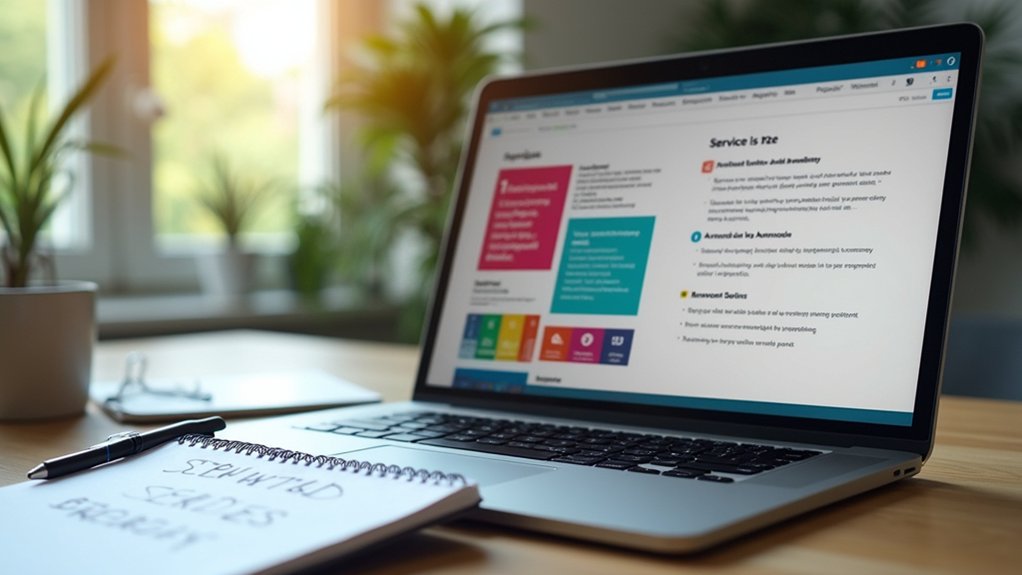![]()

You should place keywords near the start of blog titles and within the first paragraph to capture attention early. In blogs, sprinkle related terms across subheadings and maintain about 1% keyword density to engage specific queries. For services pages, prioritize high-intent keywords in titles, meta descriptions, headers, and URLs to drive conversions effectively. Blogs draw organic traffic with tailored content, while services pages focus on persuasive clarity. Exploring these strategies further helps sharpen your SEO impact.
Keyword Placement Strategies for Blog Posts
Although crafting engaging content is essential, strategically placing keywords in your blog posts greatly boosts your search engine visibility. You should position your primary keyword near the beginning of the title to enhance relevance. Incorporate it within the first paragraph to signal your topic early. Then, embed keywords in two to three subheadings to clarify your content’s structure. Maintain a keyword density near 1% to balance natural flow and SEO effectiveness. Additionally, use related variations and synonyms to capture semantic searches, enriching context without risking keyword stuffing penalties. This precise strategy elevates your blog’s ranking potential and reader engagement. For businesses targeting specific regions, integrating local SEO strategies can significantly improve your visibility and attract nearby customers. Incorporating content optimization as part of your approach ensures your blog is aligned with effective National SEO strategies.
Optimizing Keyword Use on Services Pages

While keyword placement in blog posts focuses on engaging readers with informative content, services pages demand a more targeted approach to drive conversions and attract qualified leads. You should position primary keywords at the beginning of the page title and incorporate them naturally in meta descriptions to boost click-through rates. Use header tags strategically—H1 for your main service and H2 for subcategories—to enhance SEO and readability. Craft descriptive URLs with relevant keywords to improve both search visibility and user comprehension. Throughout your content, integrate keywords carefully, avoiding stuffing, to maintain clarity and persuasive messaging that converts visitors effectively. Additionally, leveraging insights from a competitive analysis can help refine keyword strategy to outperform rivals and attract more organic traffic. Partnering with a White Label SEO provider can streamline this process by providing expert SEO management while allowing you to maintain your brand’s identity.
Comparing Keyword Goals: Blogs vs. Services Pages

When you craft content for blogs versus services pages, your keyword goals must align with their distinct purposes and audience intent. Blogs target long-tail keywords addressing specific queries, enhancing engagement through strategic placement in titles and subheadings while encouraging interaction. Services pages prioritize high-intent keywords focused on conversion, optimizing title tags, meta descriptions, and headers to guide users toward actions. Blogs build organic traffic via updated, informative content; services pages emphasize evergreen content driving conversions. Mastering these differing goals enables you to develop a thorough SEO strategy that balances informative reach with targeted conversion outcomes effectively.
Frequently Asked Questions
Where Is the Best Place to Put Your Keywords?
You should place your keywords strategically in title tags, headers, and the first paragraph to signal relevance. Also, integrate them naturally throughout the content, including meta descriptions and URLs, ensuring readability and ideal search engine indexing.
How Do I Include Keywords in a Blog?
You should strategically place your primary keyword in your blog’s title, first paragraph, and meta description. Use related keywords in subheadings and maintain a natural keyword density of about 1% to optimize readability and SEO impact.
Where Do I Put My Blog on My Website?
Place your blog prominently within your main navigation as its own section labeled “Blog.” This strategic positioning enhances user experience, boosts SEO through organized categories, and signals site activity to search engines for improved authority and ranking.
How Many SEO Keywords Should I Use in a Blog Post?
You should use one or two primary SEO keywords per blog post, maintaining about 1% keyword density. Strategically place them in titles, first paragraphs, and subheadings to optimize visibility without risking keyword stuffing penalties.



